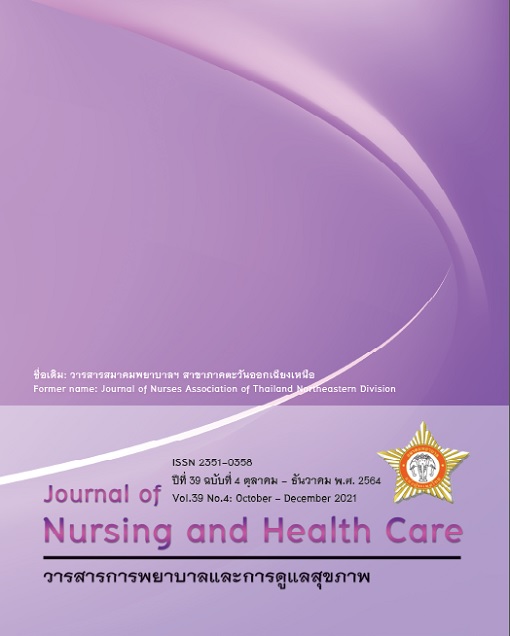การวิเคราะห์มโนทัศน์: ภาระการรักษาสำหรับการเจ็บป่วยเรื้อรัง
คำสำคัญ:
ภาระการรักษา, การวิเคราะห์มโนทัศน์, การเจ็บป่วยเรื้อรังบทคัดย่อ
ภาระการรักษาเป็นมโนทัศน์ที่สำคัญในการดูแลผู้ป่วย แต่ยังไม่มีความชัดเจนและคลุมเครือโดยเฉพาะในปรากฎการณ์ทางการพยาบาลผู้ป่วยที่มีการเจ็บป่วยเรื้อรัง บทความนี้นำเสนอการเคราะห์มโนทัศน์ภาระการรักษา โดยใช้หลักการและขั้นตอนของวอล์คเกอร์และแอแวนท์ 8 ขั้นตอน ได้แก่ 1) การเลือกมโนทัศน์ 2) วัตถุประสงค์ของการวิเคราะห์ 3) ระบุการใช้มโนทัศน์ที่สามารถค้นหาได้ 4) การกำหนดคุณลักษณะของมโนทัศน์ 5) การระบุกรณีศึกษาที่ครอบคลุมคุณลักษณะของมโนทัศน์ 6) การระบุกรณีศึกษา ได้แก่ กรณีศึกษาที่มีความก้ำกึ่ง และกรณีศึกษาแบบตรงกันข้าม 7) การระบุสิ่งที่มาก่อนและผลที่เกิดขึ้น และ 8) การกำหนดสิ่งที่จะวัด ผลการวิเคราะห์ พบว่า ภาระการรักษา หมายถึง ภาระงานในการดูแลสุขภาพที่เกิดจากการรักษาโรคเรื้อรังอย่างน้อยหนึ่งโรคและภาระการรักษาส่งผลกระทบต่อการทำหน้าที่และสุขภาวะของผู้ป่วย โดยมีคุณลักษณะ 5 ด้าน ได้แก่ 1) การจัดการเกี่ยวกับยา 2) การจัดการและการปฏิบัติการรักษาโดยไม่ใช้ยา 3) เงื่อนไขและการติดตามผลการรักษา 4) การได้รับการสนับสนุนและจัดระบบการดูแลโดยมีผู้ดูแลอย่างเป็นทางการ และ 5) การเรียนรู้และพัฒนาความเข้าใจเกี่ยวกับความเจ็บป่วยและการรักษา
Downloads
เอกสารอ้างอิง
1. World Health Organization. Noncommunicable Diseases Country Profiles 2018. Geneva, World Health Organization; 2018.
2. Bureau of Non-Communicable Diseases. Annual Report 2019. Ministry of Public Health, Thailand; 2020.
3. Kim E, Gupta S, Bolge S, Chen CC, Whitehead R, Bates JA. Adherence and outcomes associated with copayment burden in schizophrenia: a cross-sectional survey. J Med Econ 2010; 13(2): 185-92.
4. Brod M, Valensi P, Shaban JA, Bushnell DM, Christensen TL. Patient treatment satisfaction after switching to NovoMix(®) 30 (BIAsp 30) in the IMPROVE™ study: an analysis of the influence of prior and current treatment factors. Quality of Life Research 2010; 19(9): 1285-93.
5. Chen H, Cisternas MG, Katz PP, Omachi TA, Trupin L, Yelin EH, et al. Evaluating quality of life in patients with asthma and rhinitis: English adaptation of the rhinasthma questionnaire. Annals of allergy, asthma & immunology : official publication of the American College of Allergy, Asthma, & Immunology 2011; 106(2): 110-18.
6. Wilcox AR, Dragnev MC, Darcey CJ, Siegel CA. A new tool to measure the burden of Crohn's disease and its treatment: do patient and physician perceptions match? Inflammatory bowel diseases 2010; 16(4): 645-50.
7. Corona J, Matsumoto H, Roye DP, Vitale MG. Measuring quality of life in children with early onset scoliosis: development and initial validation of the early onset scoliosis questionnaire. Journal of pediatric orthopedics 2011; 31(2): 180-5.
8. Gallacher K, May CR, Montori VM, Mair FS. Understanding patients' experiences of treatment burden in chronic heart failure using normalization process theory. Annals of family medicine 2011; 9(3): 235-43.
9. Walker LO, Avant KC. Strategies for theory construction in nursing. 5th ed. Boston: Prentice Hall; 2011.
10. Demain S, Gonçalves A-C, Areia C, Oliveira R, Marcos AJ, Marques A, et al. Living With, Managing and Minimising Treatment Burden in Long Term Conditions: A Systematic Review of Qualitative Research. PLOS ONE 2015; 10(5): 1-18.
11. Coates V. Role of nurses in supporting patients to self-manage chronic conditions. Nursing Standard 2017; 31(38): 42-6.
12. Fortin M, Salisbury C, Mercer S. ABC of Multimorbidity. Chichester, West Sussex: BMJ Books; 2014.
13. Kahn LS, Vest BM, Madurai N, Singh R, York TR, Cipparone CW, et al. Chronic kidney disease (CKD) treatment burden among low-income primary care patients. Chronic illness 2015; 11(3): 171-83.
14. Saleh-Langenberg J, Flokstra-de Blok BMJ, Goossens NJ, Kemna JC, Velde JL, Dubois AEJ. The compliance and burden of treatment with the epinephrine auto-injector in food-allergic adolescents. Pediatric Allergy and Immunology 2016(1): 28-34.
15. Drabe N, Steinert H, Moergeli H, Weidt S, Strobel K, Jenewein J. Perception of treatment burden, psychological distress, and fatigue in thyroid cancer patients and their partners - effects of gender, role, and time since diagnosis. Psycho-oncology 2016; 25(2): 203-9.
16. Eton DT, Elraiyah TA, Yost KJ, Ridgeway JL, Johnson A, Egginton JS, et al. A systematic review of patient-reported measures of burden of treatment in three chronic diseases. Patient Relat Outcome Meas 2013; 4: 7-20.
17. Mair FS, May CR. Thinking about the burden of treatment. Bmj 2014; 349: 6680-89.
18. World Health Organization. Diagnosis and Management of Adverse Drug Reactions. Geneva: World Alliance for Patient Safety; 2007.
19. Moss L, Crane PB. Exploring polypharmacy in elderly women after myocardial infarction. Journal of Women & Aging 2010; 22(1): 22-33.
20. Zucca A, Boyes A, Newling G, Hall A, Girgis A. Travelling all over the countryside: Travel related burden and financial difficulties reported by cancer patients in New South Wales and Victoria. Australian Journal of Rural Health 2011; 19(6): 298-305.
21. Brod M, Cobden D, Lammert M, Bushnell D, Raskin P. Examining correlates of treatment satisfaction for injectable insulin in type 2 diabetes: lessons learned from a clinical trial comparing biphasic and basal analogues. Health and Quality of Life Outcomes 2007; 5(1): 1-10.
22. Henry DH, Viswanathan HN, Elkin EP, Traina S, Wade S, Cella D. Symptoms and treatment burden associated with cancer treatment: results from a cross-sectional national survey in the U.S. Supportive care in cancer : official journal of the Multinational Association of Supportive Care in Cancer 2008; 16(7): 791-801.
23. Olinder AL, Kernell A, Smide B. Missed bolus doses: devastating for metabolic control in CSII-treated adolescents with type 1 diabetes. Pediatric Diabetes 2009; 10(2): 142-8.
24. Nicholl D, Akhras KS, Diels J, Schadrack J. Burden of schizophrenia in recently diagnosed patients: healthcare utilisation and cost perspective. Current Medical Research and Opinion 2010; 26(4): 943-55.
25. Ow R. Burden of care and childhood cancer: experiences of parents in an Asian context. Health Soc Work 2003; 28(3): 232-40.
26. Gallacher K, Morrison D, Jani B, Macdonald S, May CR, Montori VM, et al. Uncovering treatment burden as a key concept for stroke care: a systematic review of qualitative research. PLoS Med; 2013.
27. Venes DA. Taber's Cyclopedic Medical Dictionary: F.A. Davis Company; 2017.
28. Vijan S, Hayward RA, Ronis DL, Hofer TP. Brief report: the burden of diabetes therapy: implications for the design of effective patient-centered treatment regimens. J Gen Intern Med 2005; 20(5): 479-82.
29. Thomas P. The stable patient with schizophrenia — From antipsychotic effectiveness to adherence. European Neuropsychopharmacology 2007; 17, Supplement 2:S115-S22.
30. Martire LM, Schulz R, Reynolds CF, Karp JF, Gildengers AG, Whyte EM. Treatment of Late-Life Depression Alleviates Caregiver Burden. Journal of the American Geriatrics Society 2010; 58(1): 23-9.
31. Tran V-T, Harrington M, Montori VM, Barnes C, Wicks P, Ravaud P. Adaptation and validation of the Treatment Burden Questionnaire (TBQ) in English using an internet platform. BMC Medicine 2014; 12(1): 109-119.



